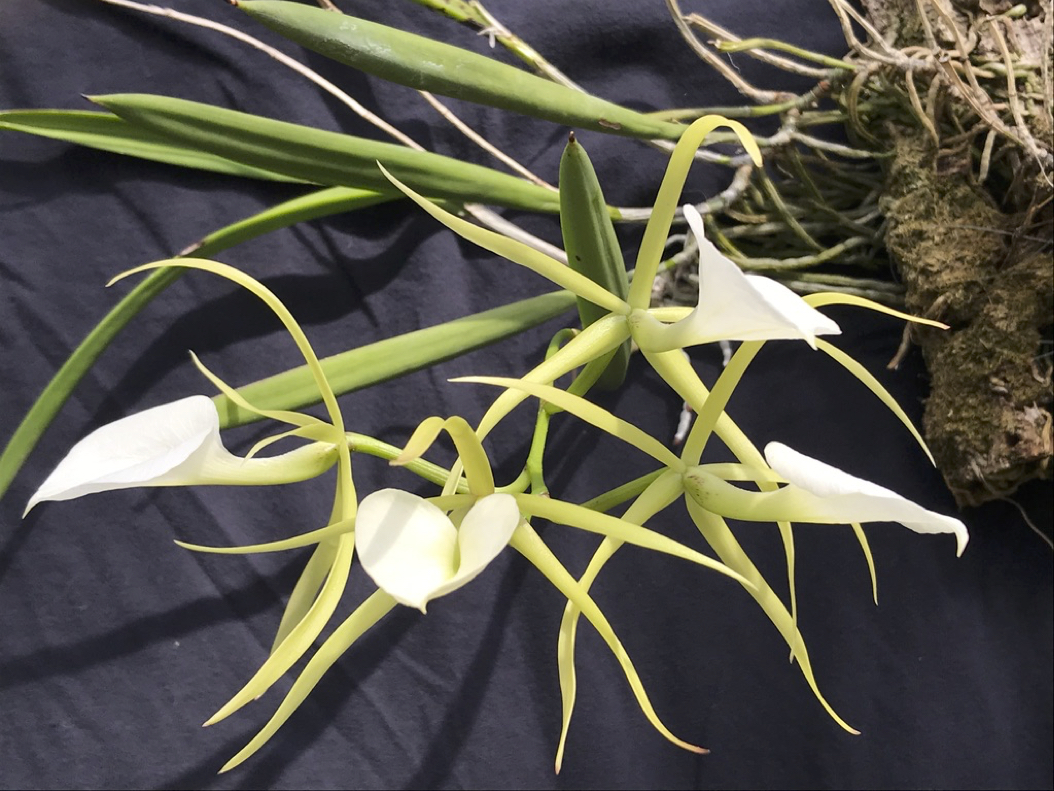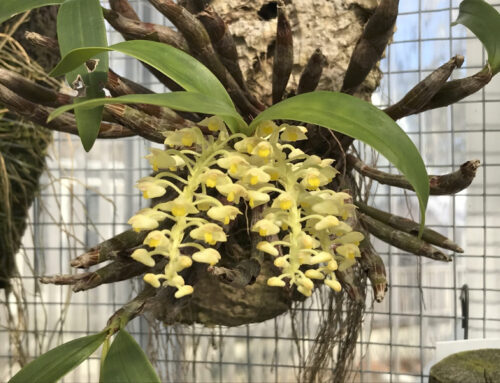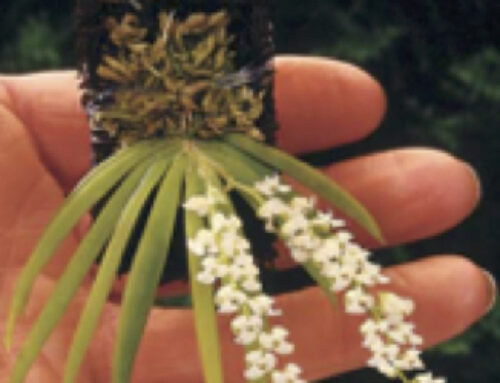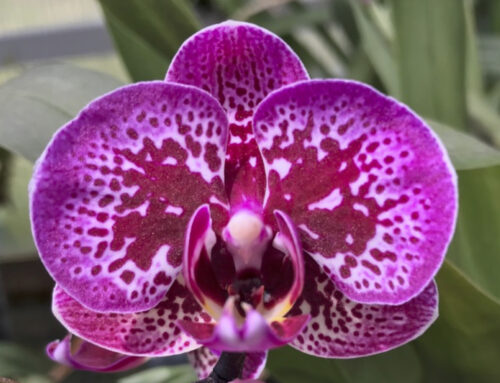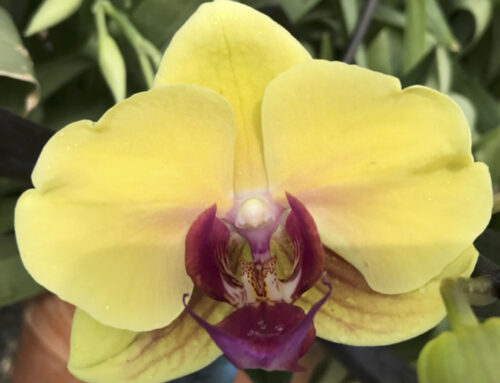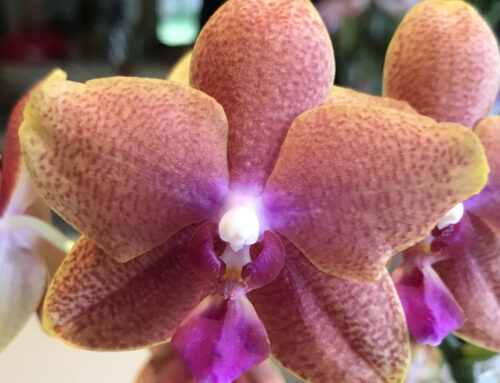By Bob Findlay
Many horticulturally important orchids originate from forests that are under the influence of monsoons. A monsoon is a seasonal reversing wind accompanied by corresponding changes in precipitation. Biologists often refer to these areas as “dry tropical forests” and they are characterized by dramatic swings in monthly rainfall totals (as much as 10” in the rainy season and as little as 0.1” in the dry season). What does this mean for our culture of orchids from these regions – dry winter rest! So what is a dry winter rest – simply put it is a period of a few weeks to several months where water and fertilizer is significantly reduced or totally withheld. Many species also benefit from an increase in light levels and slightly cooler temperatures during this time. Ed Lysek and Sandra Svobada, in an article reprinted from the Orchid Digest, cover the basics for the many of the deciduous groups as well as offering a practical view of just how to offer your orchids a dry winter rest.
Many of us reduce watering frequency during winter to account for decrease daylength and increased number of dark, gloomy days here on Cape Cod. In their Orchid Digest article Ed Lysek and Sandra Svobada state “Many cattleyas, laelias, and oncidiums will finish growing by the end of autumn and should be hardened off with reduced water and fertilizer but not the Spartan regime of other genera. Fertilizing with less frequency will make these genera happy and prevent them from breaking into unwanted off-season growth that frequently delays flowering.” However, this does not tell the whole story for many Central and South American species. Western (Pacific) Mexico, Central American and regions within Brazil experience large seasonal differences in rainfall similar to those typically associated with classic monsoon region of central Africa, India, Asia and the north of Australia.
Take Encyclia cordigera for example. It is distributed from southern Mexico, through Central America, and into Colombia and Venezuela

from Stan and Sanchez-Azofeifa (2019)
and is common in the rather dry, scrubby forests of coastal region. Compare its distribution to that of the biome “Dry tropical forest” pictured above. For San Salvador, El Salvador rainfall varies with the season (as it does for all regions with the dry tropical forest biome). Monthly rainfall averages nearly 12” per month for June through September and about 0.3 inches December through March. During the rainy season there are, on average, only 3 days per month clear at noon while during the dry season there are 20+ days clear at noon (from Baker and Baker Orchid Species Culture website (https://www.orchidculture.com); Encyclia cordigera culture page). In my experience, this species needs more than “hardening off” to grow and flower well – a dry winter rest is called for.
How does one identify species and their hybrids that require such cultural conditions? One can search the web for “orchid dry winter rest” and find some information but the best way I have found is to search for distribution information and then pick a nearby city and look at climate charts or use the cultural information compiled by Charles and Margaret Baker (Orchid Species Culture – https://www.orchidculture.com). There are 50 sample sheets available for free and hundreds, likely thousands, available at $1 per sheet (or less if you buy more).
How do I provide a dry winter rest? I grow in a greenhouse, so November 1 plants are sorted by the degree of rest I will provide. For plants to be rested, this is the last time they will be fertilized until March. There are three groups – those being hardened off (many of the Cattleya hybrids, Brassia species and hybrids, etc.), those watered every two weeks (Coelogyne fimbriate, Encyclia (Dinema) polybulbon, etc.) and those water once a month (see list below). All plants are water on November 15th and December 1st. From this point, all plants being hardened off are water approximately once a week unless we hit a long cloudy damp period (all too common on Cape Cod) when the no water period can extended upwards of 2 weeks. Those being watered every 2 weeks will be watered on the 15th and 1st of each month until February 15th, when watering will be ramped up over the next two weeks to spring norms. Those being water once a month will be watered January 1st and February 1st; beginning February 15 these plants will also begin the transition to springtime watering norms.
Here as some of the South and Central American (with a few south Florida and Caribbean species mixed in) that I rest during the winter months along with the Asian genera discussed by Lysek and Svobada:
Brassavola nodosa
Broughtonia sanguinea
Cattleya leopoldii – dry warm winter rest
Cattleya percivaliana
Encyclia alata
Encyclia cordigera
Encyclia pyriformis
Encyclia tampensis
Laelia sincorina
Oncidium (Rossioglossum) ampliatum
Rhyncholaelia glauca
Sophronitis (Cattleya) brevipedunculata but not Sophronitis (Cattleya) coccinea
Rupicolous Laelia – L. milleri, L. mantiqueirae, L. briegeri – note these species originate from the Cerrado biome pictured in the map from Stan and Sanchez-Azofeifa (2019).
Epicyclia Serena O’Neill (75% Encyclia cordigera) plus several other Encyclia hybrids that are 50% or more E. cordigera, E tampensis, E. pyriformis, and/or E. alata

